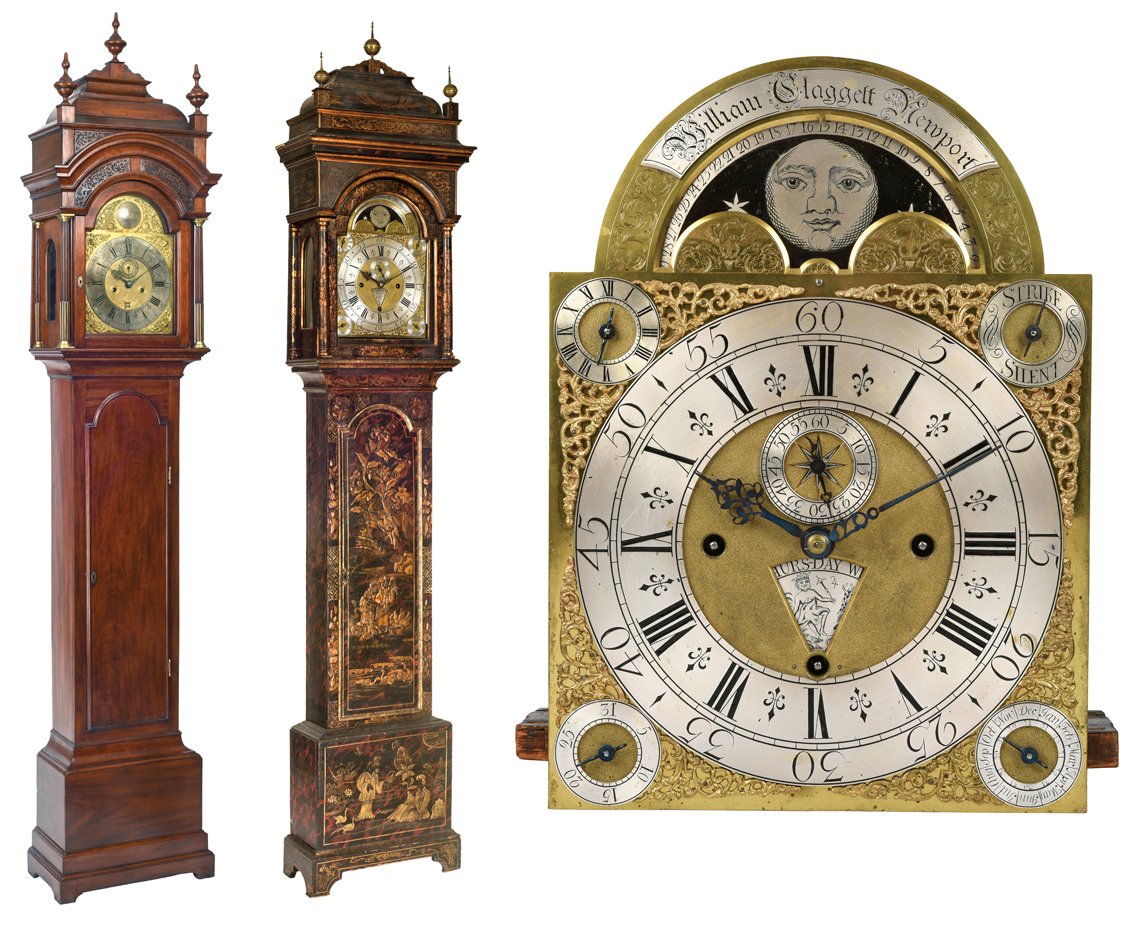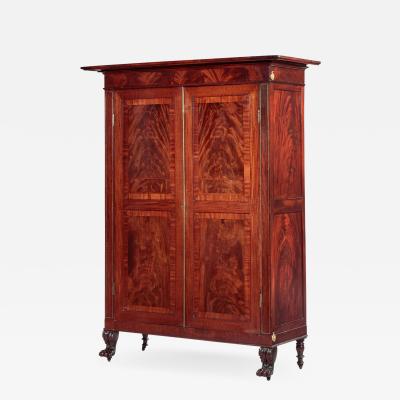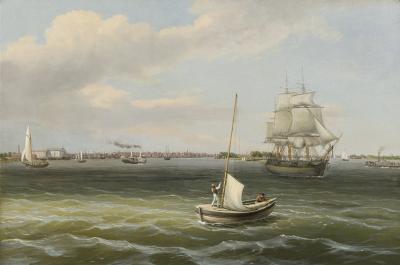Claggett: Newport’s Illustrious Clockmakers
 |
Left: Fig. 1: Square-dial, eight-day clock made by William Claggett in Newport, R.I., between 1716 and 1720. Housed in a Newport-made walnut case with gilded finials, it was made for a member of the Gorton family of Warwick, Rhode Island. H. 89, W. 19, D. 10½ in. Private collection. Center: Fig. 2: Arch-dial, eight-day clock made by William Claggett in Newport, R.I., between 1725 and 1735. It is in a Newport-made walnut case embellished with panels of figured burl walnut and gilded finials. H. 94½, W. 21, D. 11⅜ in. Private collection. Right: Fig. 3: Dial of the clock pictured in figure 2. Of particular note is the scale and pointer in the arch. The latter controls a cam and lever mechanism that lowers (lengthens) or raises (shortens) the pendulum to slow down or speed up the clock. This is a most unusual method of adjusting the speed of a tall clock, the norm being a threaded extension and nut at the bottom of the pendulum rod to raise or lower the bob only. |
William Claggett (1694–1748) was born to the baker Caleb Claggett and his wife Ann in London, England; they had him baptized in St. Olave’s Church, in what is now the London Borough of Southwark, on October 30, 1694.1 Beyond that, the details of William Claggett’s youth are cloaked in mystery, but it is certain that he was apprenticed to learn clockmaking with a currently unknown master in London, while his father struggled to earn a living by baking. His father ultimately failed in business and left London with his family for Boston, Massachusetts, in 1714. Shortly after arriving, William wooed and married Mary Armstrong and set himself up in business as a clockmaker. However, it appears he met with robust competition from at least five other English clockmakers who had preceded him to Boston. So, he and his father relocated with their families to Newport in 1716. The move was prescient, for William went on to fame, though not necessarily great financial success, as Newport’s preeminent clockmaker and one of the most admired in early America.
Shortly after he settled in Newport, Claggett made a clock for a member of the Gorton family — probably Samuel Gorton (1672–1722) — of Warwick, Rhode Island (Fig. 1). Housed in a Newport-made walnut case, the square-dial, eight-day clock nicely represents his early work. The movement is fronted with an 11 ½-inch square brass dial that indicates the hour, the minute, the second, and the date of the month. The silvered chapter rings and name plate, coupled with the gilt lacquered corner spandrels, impart a bright, attractive, and decorative aspect to its functional purpose.
By the early 1720s, demand for clocks with an arch dial had become the norm in the North American colonies. A fine example of an arch dial clock made by William Claggett, housed in a Newport-made walnut and veneered burl walnut case, is pictured in Figures 2 and 3. While the configuration of the square portion of its dial is essentially the same as the clock in figure 1, the arch above it provides a dramatic new aspect that not only influenced the design of the case housing it, but offers multiple new opportunities for additional time-related information. The arch provides space for an attention-getting silvered name boss flanked by sprightly winged putti. In addition, it employs a graduated scale at its perimeter that, in conjunction with the blued steel pointer, allows one to advance or retard the speed of the movement by raising (shortening) or lowering (lengthening) the pendulum.
 |
| Left: Fig. 4: Arch-dial, eight-day clock made by William Claggett in Boston. Mass., between 1735 and 1748. It is housed in a Boston-made walnut case embellished with brass and panels of blind fretwork and was commissioned by John Cushing of Scituate, Mass. H. 104¼, W. 21, D. 11 in. Private collection. Center: Fig. 5: Arch-dial, eight-day, quarter-striking clock made by William Claggett in Newport. R.I., between 1735 and 1748. It is housed in a Boston-made japanned pine case and was commissioned by a member of the Stanton family of Newport. H. 103½, W. 21¾, D. 10⅞ in. Courtesy of the Redwood Library and Athenaeum. Right: Fig. 6: Dial of the clock pictured in figure 5. Engraved by Claggett with the expected Roman numerals and Arabic numbers, he also embellished this clock dial with impressive pictorial elements, like the man-in-the-moon, and masterful alphabetic lettering with calligraphic flourishes in the arch. |
Another of Claggett’s arch dial clocks with a name boss is housed in a Boston-made mahogany case and was made between 1735 and 1748 for John Cushing (1695–1778) of Scituate, Massachusetts (Fig. 4). It is notable that Claggett recorded his location as “Boston” on the engraved name boss of this clock, instead of the usual “Newport,” confirming that he did not completely give up his connections with the former when he relocated to the latter. This clock nicely demonstrates the influence the arch dial had on clock case design, visible not only in the arched dial door, but also the arched pendulum door below it and the arched lights (windows) on either side of the hood.
The clock pictured in Figures 5 and 6 is often considered to represent the pinnacle of William Claggett’s artistry as a clockmaker. It was made between 1735 and the date of his death, probably for a member of the Stanton family of Newport, and is housed in a Boston-made japanned pine case, reflecting the popularity of Asian design at the time. The movement strikes every fifteen minutes on a nest of six bells, and on the hour with a seventh bell. It is configured, and the dial impressively designed to tell the hour, minute, second, day of the week (in the wedge-shaped aperture under the clock hands), the month, and its number of days (in the lower right corner), along with the day of the month (in the lower left corner), the hour of high tide in Newport harbor (in the upper left corner), the phase of the moon, and day of the lunar month (in the arch). In addition, its bells can be silenced with the switch in the upper right corner.
This clock dial also demonstrates William Claggett’s talent as an engraver. Like all clockmakers, he had to be competent at engraving functional features like Roman numerals and Arabic numbers. However, he far excelled his counterparts in his ability to engrave pictorial adjuncts like the figure of Jupiter in the wedge-shaped aperture and the man-in-the-moon in the arch. Equally impressive is his facility with decorative line engraving and alphabetic lettering, also in the arch.
Claggett was not only a clockmaker. He worked with his father as a baker, engraved copper plates for printing money for the colony, experimented with static electricity and pursued various business opportunities, all the while keeping his clock making and repair business solvent. Toward that end, he had shop staff who worked for him. James Wady (circa 1706–1759), who was probably born in London and emigrated to Boston after apprenticing to his uncle John Wady, moved to Newport, and worked for Claggett as a journeyman from about 1729 to about 1747. He is Claggett’s best-known employee. Following Claggett’s death, Wady attempted clock making for a short time on his own, but that ended in 1753, at which time his personal and business life spiraled downward toward his death as a pauper. The few years during which Wady worked as an independent clockmaker probably account for the few clocks bearing his name that are presently known; the authors know of only eleven. Nevertheless, James Wady was a talented clockmaker, as illustrated by the clock in figure 7 that he made between 1747 and 1753 for a member of the Wanton family of Newport. Housed in an ambitious Newport-made mahogany case, it relates closely to those of his master, most notably in the use of a tides dial in the upper left corner. This particular horological solution to predicting tides is unique to William Claggett and his journeyman, occurring nowhere else in the Anglo-American world.
 |
Far Left: Fig. 7: Arch-dial, eight-day clock made by James Wady in Newport between 1747 and 1753 for a member of the Wanton family of Newport. Housed in a Newport-made mahogany case embellished with a carved gilded shell and finial and panels of blind fretwork fronting yellow fabric. H. 102½, W. 19¼, D. 10¼ in. Private collection. Center Left: Fig. 8: Dwarf arch-dial, seven-day timepiece (with no strike train or bell) made by Thomas Claggett in Newport, R.I., between 1755 and 1776, or 1779 and 1780 (the three-year hiatus reflecting his sojourn in Providence during the Revolutionary War). It is housed in a Newport-made mahogany case. H. 65⅞, W. 16, D. 9¾ ins. Courtesy the Winterthur Museum, Garden & Library. Center Right: Fig. 9: Arch-dial, eight-day clock made by Thomas Claggett in Newport, R.I., between 1755 and 1779, or 1779 and 1780. It is housed in a Newport-made mahogany case. H. 94¾, W. 21⅜, D. 11¼ ins. Private collection. Far Right: Fig. 10: Dial of the clock pictured in figure 9. This dial is competently engraved with alpha-numeric features, in addition to sprightly squirrels flanking Claggett’s name in the arch. The rotating portion of the arch is painted with polychrome moon and landscape vignettes. A comparison with the William Claggett dial in figure 6 evinces notable differences in design and execution by the two men. |
Thomas Claggett, the third of the Newport clockmakers discussed, has long been accepted as William’s son, but we found no evidence to support that contention. Circumstantial evidence suggests they were probably related, but not as father and son. There is no record of where and when Thomas was born, or with whom he trained. He first appears in Newport in the clock-making business in 1752. He continued there, presumably with a degree of success, until 1776, when the British Army entered the city. They and the American Revolution effectively destroyed his business. Like many Newporters, he fled thirty-three miles north to Providence, where he attempted to earn a living as a clockmaker, silversmith, and by teaching swordsmanship. In 1779, at the conclusion of the war, Claggett returned to a devastated Newport, and divided his time between there, Taunton, and Dighton, both in Massachusetts. He died insane in Newport in 1797, and was buried in a pauper’s grave.
Thomas Claggett’s clocks differ from William Claggett’s and James Wady’s. In addition, they vary significantly, one from the other. The movement in the dwarf timepiece in figure 8 is smaller and simpler than those of its predecessors; it has no strike train or bell to strike the hours and it tells only the hour and minute. Furthermore, it is housed in a Newport-made mahogany case that is only two-thirds the height (just over 5 feet) of cases by William Claggett and James Wady. In contrast, the clock in figures 9 and 10 strikes the hours on a bell, and provides the hour, minute, second, date of the month, phase of the moon (with a painted moon face), and day of the lunar month. It is housed in a Newport-made mahogany case that stands not quite 8 feet tall.
The clocks made by these three makers represent a high watermark in Rhode Island’s horological legacy and stand at the pinnacle of early American colonial clock making. Apart from the impressive design and construction of their cases, they embody artistic beauty and mechanical originality. Our new book, Claggett: Newport’s Illustrious Clockmakers, brings together and presents the best of their work in conjunction with a consideration of their lives and the various local, regional and global forces that affected them. It firmly establishes their place in the world of early American horology. Yet the authors are convinced more can be done. Further research can only grow our understanding and appreciation of their work.
This article announces our book, the second in a series of three books on early American clockmakers by Donald L. Fennimore and Frank L. Hohmann III.2 Claggett: Newport’s Illustrious Clockmakers (Yale University Press, 2018) culminates the authors years-long effort to present the best of these three clockmakers’ work, as well as clarify and, in some instances, correct long-held lore about the men and their lives. Two exhibitions associated with the publication will open in Newport this December: “The Claggetts of Newport: Master Clockmakers in Colonial America,” at the Redwood Library and Athenaeum, a cosponsor, with Winterthur Museum, Library & Garden, of the publication; and a show at the Newport Historical Society.
 |
The authors wish to thank Dennis Carr, Edward Kane, Patricia Kane and Gary Sullivan for extensive and invaluable help while working on this book.
Donald L. Fennimore is curator emeritus, Winterthur Museum, Library & Garden, and was formerly metals curator at the museum. Frank L. Hohmann III is a clock collector and Liveryman in the Worshipful Company of Clockmakers.
 |
1. The authors acknowledge the seminal research and writing on the three clockmakers included in this article by Richard L. Champlin (1926–2003), librarian at the Redwood Library and Athenaeum in Newport, expanding our understanding of their work. The fruits of his pioneering research were three monographs in Newport History, the Bulletin of the Newport Historical Society. Those articles provided a firm foundation on which we have built our book.
2. Our first book in the series, titled Stretch: America’s First Family of Clockmakers, was published in 2013. The third, currently being researched, will deal with the clocks of David and Benjamin Rittenhouse; publication is planned for 2022. An article about the Stretch clockmakers by the authors appeared on pages 105–111 in the Summer 2013 issue of Antiques & Fine Art magazine.































